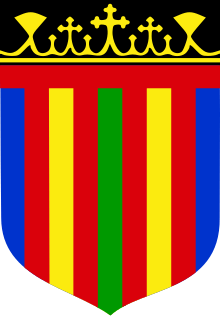Coptic flag
The Coptic flag (Coptic: ⲡⲓⲙⲏⲓⲛⲓ `ⲛⲕⲩⲡⲧⲁⲓⲟⲛ) was created in 2005 by Coptic activists in different countries to represent Coptic communities both in Egypt and in the Coptic diaspora. It is not recognized by the Coptic Orthodox Church of Alexandria, and it is not recognized by any official Coptic organization. The only Coptic organization that has recognized the flag is the New Zealand Coptic Association, which is the same association that created the flag.[1] and the Free Copts.[2]

Background
Copts voice opposition to many aspects of Egypt's political life. One of these is the present-day Egyptian flag, which many Copts feel does not represent their Egyptian identity. The pattern closely resembles those of other Arabic-speaking countries, a symbol of Arab nationalism rejected by many Copts, along with the official title of the country "Arab Republic of Egypt", as if to distinguish between an Arab Egypt and the other that is not. In this respect, taking into consideration that Copts are especially unlikely to consider themselves as Arab, the current Egyptian flag alienates the Egyptian Christian minority in its homeland.
The Coptic flag arose from the conviction that any group has a right to represent itself through an emblem or a flag in its larger society and the world. It is in line with examples such as the flag of the Lebanese Hezbollah, the flag of the Aramean minority, which flies side by side with the Syrian national flag at Aramean churches; and the flag of the Assyrian minority, which flies side by side with the Iraqi national flag at Assyrian churches. Other examples include the flag of the Kurdish minority, which flies side by side with the Iraqi national flag ; the flag of the Berber minority, the flag of the Roma (Gypsy) minority and many other ethnic minorities throughout the world.
Nevertheless, in view of the Copts' Egyptian patriotism and their attachment to their country, and from the standpoint of respecting the opinion of other Egyptians, Coptic or Muslim, who might consider the national flag representative, Copts continue to call upon respecting the current flag of Egypt. The Coptic flag came about as a compromise ; one that represents the Copts and highlights their non-Arab, non-Muslim identity. Some Copts have begun using the new flag alongside the official Egyptian flag These Copts view it as a way to reconcile their pride in their ethnic Coptic identity with their allegiance and strong attachment to Egypt, as well as with their desire for peaceful coexistence with their compatriots.
Symbolism

The Coptic Flag consists of two main components: a blue cross and a colorful coat of arms.
- The cross represents Christianity, the Copts' religion. The blue color stems from the Egyptian sky and water. It also reminds the Copts of their persecution, when some Muslim rulers forced their ancestors to wear heavy crosses around their necks until their necks became blue.[3][4]
- The top of the coat of arms is decorated with Coptic crosses intertwined with lotus flowers, representing Egyptian identity. Coptic crosses are made of four arms equal in length, each of which is crossed by a shorter arm (a form of the heraldic "Cross Crosslet"). They are different from the Latin cross that possesses three short arms and a longer arm. The lotus flower, also known as the Egyptian White Water-lily (Nymphaea lotus), is one of ancient Egypt's most highly regarded flowers. It used to represent creation and resurrection, for it disappears under water after sunset, then resurfaces and blooms at dawn. An ancient Egyptian creation myth states that the first thing to have been born from the watery chaos of the beginning of time was a giant lotus flower, which, on the first day of creation, gave birth to the sun.
The black background behind the ornaments is a symbol of Kaami (Coptic: ⲭⲏⲙⲓ), the Egyptian name of Egypt, which means the Black Land. Ancient Egyptians gave their country this name since the waters of the Nile used to bring black soil during the inundation season and deposit it on the banks of the Nile, thus fertilizing them. The contrast between the yellow and the black is a symbol of the Copts' Christian faith and Egyptian identity that still shine amid the darkness of the persecution they have been suffering over the centuries. Beneath these ornaments is a green line in the middle of the coat of arms, which represents the Nile Valley. Around it are two yellow lines that symbolize the Eastern and Western Deserts of Egypt. These two lines are in turn flanked by two blue lines that represent the Mediterranean Sea and the Red Sea that enclose Egypt. Finally, these lines are separated by red lines symbolizing the blood of the Coptic martyrs, which has been shed all over Egypt since Egyptians adopted Christianity and until today.
See also
External links
References
- "New Zealand Coptic Association". Archived from the original on 2007-09-29. Retrieved 2018-09-19.
- "Freecopts.net". freecopts.net. Archived from the original on 2011-03-01. Retrieved 2018-03-14.
- My Coptic Church - Ask A Copt
- El-Shamy, Hasan M. Folktales of Egypt. 406 p. 1980 Series: (FW) Folktales of the World ISBN 978-0-226-20625-7 (ISBN 0-226-20625-4)